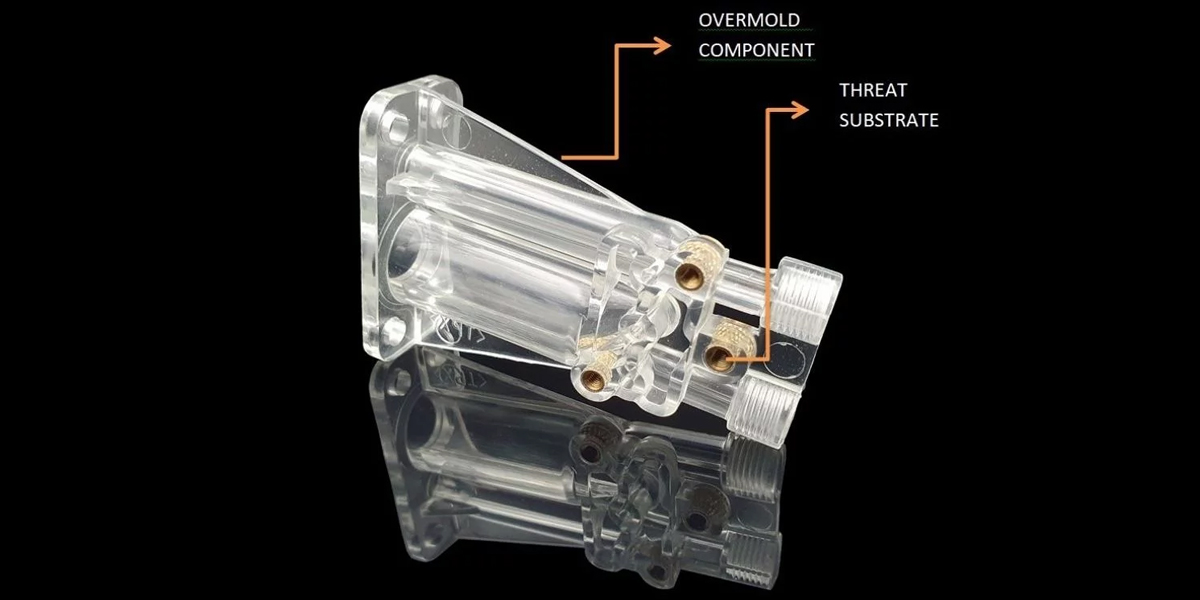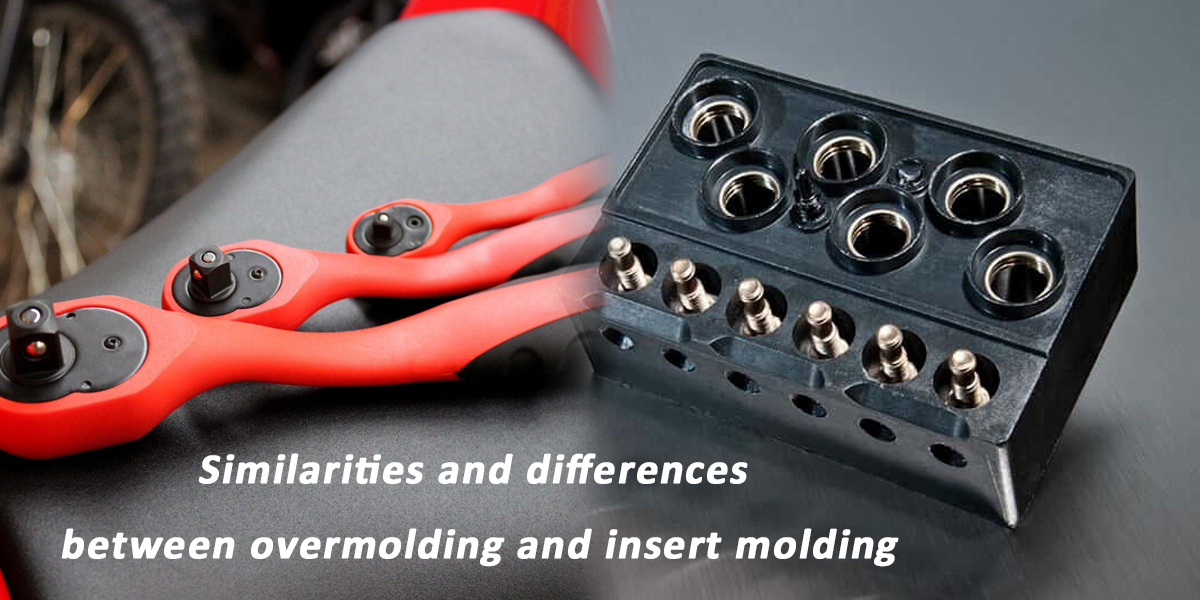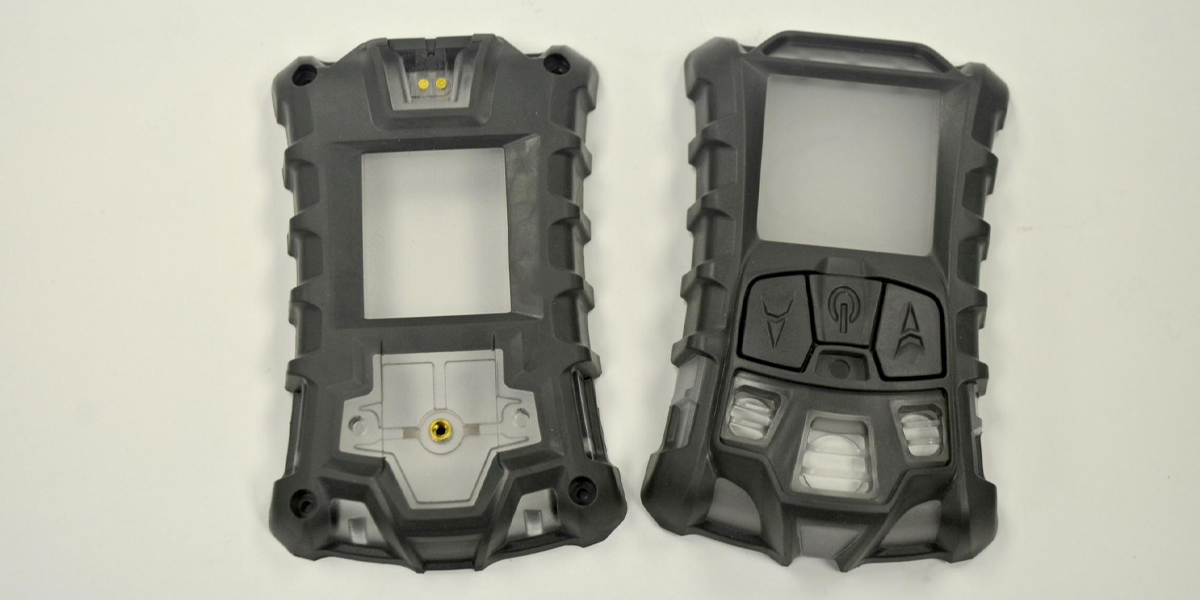
What is over molding ?
Overmolding, also known as two-shot molding or multi-material molding, is a manufacturing process used in the plastics industry to create products with multiple layers or materials. It involves the injection molding of one material over another material to create a single, integrated component. This process is commonly used to combine the properties of different materials, such as hard and soft plastics, rubber, or thermoplastic elastomers, into a single part.
How does overmolding working?
Mold Preparation: The mold used for overmolding is designed with multiple cavities. The first cavity is for the initial material injection (first shot), and the subsequent cavities are for the second material injection (second shot) and any inserts that need to be incorporated.
First Shot Injection: The first material, often a rigid plastic, is injected into the first cavity of the mold. This material forms the base or substrate of the part. The mold is then cooled partially or fully to allow the first shot to solidify, but it's still in a semi-molten state.
Insert Placement (if required): If the design involves incorporating inserts, such as metal components or electronic parts, they are positioned in the appropriate cavities of the mold. These inserts will be encapsulated by the second material during the second shot.
Second Shot Injection: The second material, typically a softer or more flexible plastic, is injected into the mold's remaining cavities. This material flows around the first shot and any inserts, bonding with the partially solidified first shot to create a cohesive and integrated part.
Cooling and Solidification: The combined part is allowed to cool and solidify within the mold. The cooling process ensures that both materials fully bond and adhere to each other, forming a strong interface between the layers.
Ejection: Once the part has completely solidified, it is ejected from the mold. The part is now a single, multi-material component.
Advantages and disadvantages of overmolding and functions——
Advantages of Overmolding:
Enhanced Ergonomics: Overmolding allows for the creation of ergonomic designs with comfortable and user-friendly grips, improving user experience and reducing fatigue during extended use.
Improved Aesthetics: Overmolding enables the combination of different materials, colors, and textures, leading to visually appealing and distinctive product designs.
Better Durability: The use of multiple materials can enhance the overall durability and longevity of products, making them more resistant to wear, impact, and environmental factors.
Customization: Overmolding allows for the incorporation of logos, patterns, and textures directly into the product's surface, offering branding opportunities and unique aesthetics.
Reduced Assembly Steps: Combining different materials in a single molding process eliminates the need for additional assembly steps, saving time and reducing the risk of assembly errors.
Improved Functionality: Overmolding can combine materials with different properties, such as hardness and flexibility, to create products that offer enhanced functionality and performance.
Comfort and Safety: Overmolding can create cushioning and padding, making products more comfortable to use and providing protection against impacts and vibrations.
Disadvantages of Overmolding:
Complex Tooling and Design: Overmolding often requires specialized molds and careful design considerations to ensure proper material adhesion and part quality, which can lead to increased manufacturing complexity and costs.
Material Compatibility: Selecting materials that adhere well and have compatible melting points is crucial for successful overmolding. Incompatibility can result in poor bonding and structural integrity.
Costs: The setup costs for overmolding can be higher due to the need for specialized molds and machinery. However, these costs might be offset by reduced assembly and production times.
Limited Material Choices: While overmolding offers material combinations, some materials might not be suitable for overmolding due to compatibility issues.
Quality Control: Ensuring consistent quality in overmolded parts requires precise control of molding parameters and material ratios, which can be challenging.
Design Constraints: Designing parts for overmolding requires careful consideration of material flow, bonding, and potential shrinkage, which can limit design flexibility.
Functionality Impacts:
Ergonomics: Overmolding can significantly improve the ergonomic features of products, making them more comfortable and user-friendly.
Durability and Protection: Overmolding enhances product durability by providing extra layers of protection against impacts, moisture, and environmental factors.
Aesthetics: Overmolding enhances product aesthetics by allowing for creative designs, textures, and branding opportunities.
Comfort and Safety: Overmolding can improve comfort by providing cushioning and soft-touch surfaces, increasing user satisfaction.
Customization: Overmolding enables customization through material choices, colors, and surface patterns, making products stand out in the market.

Similarities and differences between overmolding and insert molding:
Similarities:
Multi-Material Integration: Both techniques involve combining two or more materials within a single molded part.
Injection Molding Basis: Overmolding and insert molding are both variations of the basic injection molding process, where molten material is injected into a mold cavity to form a part.
Enhanced Features: Both techniques can enhance the features and functionality of a product, such as providing improved grip, comfort, aesthetics, and durability.
Differences:
Process Sequence:
Overmolding: In overmolding, the first material is injected into the mold to create the initial layer or substrate. The second material is then injected over the first material, forming an additional layer.
Insert Molding: In insert molding, an insert (usually a preformed component like a metal pin, electronic component, or another part) is placed into the mold cavity before the molding process begins. The molten material encapsulates the insert during molding.
Primary Material Purpose:
Overmolding: The initial material in overmolding is typically the main structural component, providing the shape and structure of the part. The second material enhances features like grip, comfort, or aesthetics.
Insert Molding: In insert molding, the insert is a distinct component that often provides a functional aspect to the final part. It might serve as a connector, reinforcing element, or other critical function.
Material Interaction:
Overmolding: Overmolding usually involves using materials with different properties, such as a rigid material for the initial layer and a soft material for the outer layer.
Insert Molding: Insert molding generally uses different materials for the insert and the surrounding material, although the materials' properties can vary based on the intended functionality.
Tooling:
Overmolding: Overmolding requires molds with multiple cavities, corresponding to the different materials or layers being used.
Insert Molding: Insert molding requires molds that can accommodate the insert placement and provide proper encapsulation during the molding process.
Complexity:
Overmolding: Overmolding can be more complex due to the need for proper bonding between different materials and managing material compatibility.
Insert Molding: While still complex, insert molding might involve fewer challenges related to material compatibility and bonding since the insert is often a well-defined component.
Applications:
Overmolding: Overmolding is often used for creating grips, handles, and products requiring multi-material aesthetics and comfort, such as tool handles, consumer electronics, and medical devices.
Insert Molding: Insert molding is commonly used for incorporating functional components, such as electrical connectors, threaded inserts, and reinforcement elements.
Overmolding focuses on layering materials for enhanced aesthetics and comfort, while insert molding emphasizes integrating functional components or inserts into the molded part for added functionality.
What need to be aware of during the overmolding process?
Material Compatibility: Selecting materials that are compatible in terms of melting points, adhesion, and bonding properties is crucial for achieving a strong and durable bond between the different layers.
Design Considerations:
Material Flow: Design the part to ensure proper material flow during both the initial shot and the overmolding shot to avoid air traps, voids, or incomplete encapsulation.
Bonding Area: Plan the bonding area between the two materials to maximize contact and adhesion. A larger bonding area often leads to better structural integrity.
Wall Thickness: Maintain consistent wall thickness throughout the part to ensure even cooling and prevent warping.
Tooling Design:
Mold Cavities: Design the mold with multiple cavities to accommodate both the initial shot and the overmolding shot. The mold should also allow for proper cooling and material flow.
Insert Placement (if applicable): If the design includes inserts, plan their proper placement to ensure they are encapsulated by the overmolded material.
Venting: Proper venting in the mold is essential to allow air and gases to escape during the molding process and prevent defects like voids or burn marks.
Injection Parameters:
Injection Speed and Pressure: Adjust injection speed and pressure to ensure proper material flow, adhesion, and bonding between the layers.
Injection Temperature: Optimize injection temperatures for both the initial shot and overmolding shot materials to prevent material degradation.
Cooling and Solidification:
Cooling Time: Allow sufficient cooling time to ensure both the initial shot and overmolding shot materials solidify properly. Insufficient cooling can lead to defects and poor adhesion.
Common materials type used in overmolding include:
Overmolding involves combining two or more materials with distinct properties to create a single, integrated part. The choice of materials is crucial to achieve proper adhesion, performance, and aesthetics. Here are some common types of materials used in overmolding:
Thermoplastic/Thermoplastic:
Hard Thermoplastic (Substrate): Materials like ABS (Acrylonitrile Butadiene Styrene), PC (Polycarbonate), and PA (Nylon) are often used as the rigid substrate in overmolding. They provide structure and strength to the part.
Soft Thermoplastic (Overmold): Materials like TPE (Thermoplastic Elastomer) or TPU (Thermoplastic Polyurethane) are used for the overmold layer. These materials offer flexibility, soft-touch surfaces, and grip-enhancing properties.
Plastic/Rubber:
Plastic (Substrate): Similar to thermoplastic substrates, hard plastics can serve as the substrate. They provide structure and stability.
Rubber (Overmold): Materials like silicone or other rubber-like compounds are commonly used for the overmold layer. They offer a comfortable and non-slip grip.
Plastic/Metal:
Plastic (Substrate): Rigid plastics like PA or PC can form the substrate, housing, or main body of the part.
Metal (Insert): Metal inserts such as pins, connectors, or electronic components can be overmolded with plastic to provide electrical insulation or improved aesthetics.
Thermoplastic Elastomer/Thermoplastic:
TPE (Substrate): TPEs can be used as both the substrate and the overmold layer. This combination provides comfort, grip, and structural support.
Thermoplastic (Overmold): Hard thermoplastics can be overmolded with TPE to create multi-material components with varying levels of hardness and flexibility.
Plastic/Foam:
Plastic (Substrate): Rigid plastics provide the structural base for the part.
Foam (Overmold): Foamed materials can be overmolded to create cushioned surfaces with enhanced comfort and impact absorption.
Rubber/Plastic:
Rubber (Substrate): Rubber can serve as the primary material, providing flexibility and grip.
Plastic (Overmold): Hard plastics can be overmolded onto rubber to provide structural support and added features.
Color Variation:
Overmolding can also involve using different colors of the same type of plastic to create visually appealing designs. This is often seen in consumer products.
Over molding application:
Overmolding finds application in various industries and products where combining different materials or incorporating functional features is beneficial.
Consumer Electronics:
Mobile Phone Cases: Overmolding provides both protection and aesthetics by combining rigid and soft materials for enhanced grip and shock absorption.

Remote Controls: Overmolding improves ergonomics and user comfort by creating soft-touch buttons and comfortable grips.
Automotive Industry:
Steering Wheel Grips: Overmolding creates comfortable and aesthetically pleasing grips that enhance the driving experience.
Gearshift Knobs: Overmolding can create stylish and ergonomic gearshift knobs for improved usability.
Medical Devices:
Surgical Instruments: Overmolding improves the grip and comfort of surgical tools, making them easier for medical professionals to use during procedures.
Hearing Aid Shells: Overmolding creates custom-fit shells with comfortable and non-irritating surfaces.
Sporting Goods:
Bicycle Handle Grips: Overmolding provides shock absorption and comfortable grips for enhanced control during rides.
Tennis Racket Handles: Overmolding improves the grip and reduces vibration, enhancing player performance.
Tools and Equipment:
Hand Tool Grips: Overmolding creates ergonomic grips for tools, reducing user fatigue and improving control.
Power Tool Handles: Overmolding enhances user comfort and grip on power tools during operation.
Household Appliances:
Blender Controls: Overmolding can create user-friendly and visually appealing controls for household appliances.
Vacuum Cleaner Handles: Overmolding provides comfortable handles for easy maneuvering of appliances.
Medical Products:
Dental Instrument Grips: Overmolding enhances the ergonomics and grip of dental instruments, improving dentist comfort and precision.
Electronics Accessories:
Camera Grips: Overmolding creates comfortable grips for cameras, enhancing handling during photography.
Game Controller Grips: Overmolding improves the grip and comfort of gaming controllers for extended gameplay.
Industrial Equipment:
Industrial Tool Handles: Overmolding provides comfortable and durable grips for industrial tools, reducing operator fatigue.
Outdoor Equipment:
Garden Tool Handles: Overmolding enhances the grip and usability of garden tools for improved gardening experiences.
Camping Equipment: Overmolding can be used to create comfortable grips on camping equipment like lanterns and cookware.